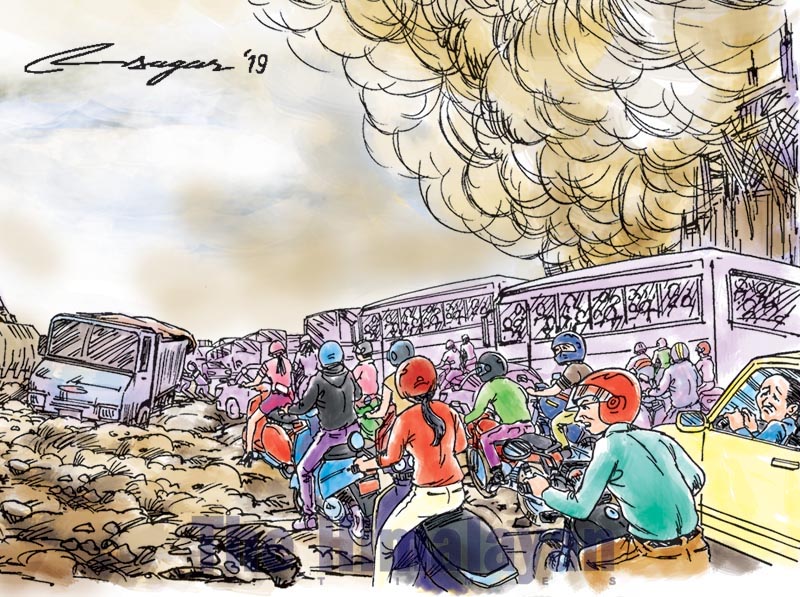No mercy to the roads: So let’s define carrying capacity
To keep the road infrastructure in condition, every single road needs to be defined with its carrying capacity. It could then decide on the number, types and time for vehicles to run over them
Roads! Quite helpless in Kathmandu as I can see. Only because they are not living. Had they been living, they would have felt the agony of how brutally they are being used. If any mishap occurs, the first blame goes to the roads. As a road user, whether a pedestrian, biker or driver, you definitely tend to curse the road first if anything went wrong with you. We seldom feel how the roads have come along till now.
In Nepal, roads are always in a pitiful condition throughout the year. Everyday you’ll see hundreds of thousands of vehicles rolling over them hastily.
Along with the utility prospect of the roads, their condition has also been overlooked. That’s why the roads are full of dust during the dry season and muddy when wet.
Sometimes, you even see animals lying in the midst of the bare roads with no traffic signage. At the end of the day, you hear a number of accidents happening on these roads, which definitely is not soothing to our ears. So, it’s high time to think whether these accidents are occurring because of the roads or because of the way we are using them.
According to American urban planner Kevin Lynch, pathways are one of the five key elements portraying the image of a city. Paths generally can be denoted by railways, highways, roads, streets, tracks and lanes. It’s not only the beauty and services that portray the image of a city but also the users who add value to it.
Roads thus add substantially to city morphology and urban environment. For a commoner, good roads are a parameter of the development index, too. But functionally, they guide people in making travel for various purposes. So, they are a means of numerous activities of public domain, and hence their conditions undoubtedly impact urban life. The utilitarian prospect and condition prospect of our roads raise many queries.
The commonly seen roads lack drainage, footpaths, greenery, lighting and street furniture. So there is a high risk of potential conflict between vehicles and pedestrians. Blacktopping only the road middle is the mindset of the authority during construction, not the edges and other accessories of the road. We have still not been able to think of other public amenities to bring comfort for the ordinary citizens using roads.
Ironically, “Ashare Bikas” is the term we have been hearing every time near the end of the fiscal year, when we witness road construction happening hastily simply to finish the allocated budget.
This also applies to other infrastructures like sanitation, water supply, electricity and telecom that end up digging up the roads and leaving them as they are.
An integrated and coordinated way to involve all these line agencies and respective departments at the time of construction has never happened in Nepal.
Furthermore after the declaration of the federal state, roads are being built in rampant rapidity across the country with the ambitious vision to provide connectivity and basic infrastructure.
But the roads have remained incomplete everywhere and proved a bane to the natural environment. Agricultural lands, beautiful hills and forests have been penetrated, leading to consecutive landslides in the monsoon.
If we look keenly at the traffic clots in the Kathmandu Valley, they indicate the abuse of traffic rules and the insanity people show on the roads. Hundreds of vehicles occupy the entire road in a bid to get out of the traffic junction when the signal is given. Had they queued into a single lane, they would have easily crossed over. Do we really need traffic personnel at every corner of a street? Do we really take care of signs on the roads? Why are people in haste on the streets?
Of course, our traffic infrastructure systems do fail frequently, which is one of the reasons for not being able to tame the people. The traffic lights do not work and the traffic signs have faded away. Who is to blame - the people or the authority? To keep the road infrastructure in place and in condition, every single road needs to be defined with its carrying capacity. It could then decide on the number, types and time for vehicles to run over them. Otherwise, the notion of roads would be the same for bicycles, heavy loaders, two wheelers, four wheelers and pedestrians.
Similarly, pedestrians, public transportation, government official vehicles, goods carriers and private vehicles should be included hierarchically into a priority list on every street. Generally, pedestrians and cyclists should get priority, with private vehicles getting the least.
This would enable the authority to maintain the road infrastructure properly and introduce road permits and taxation systems accordingly.
Look at the way roads are being maintained in Nepal, you will never convince yourself that they are good enough to move on. The streets are swept, but the dust is heaped on the road side and never collected. Craters get filled with rubble, but never get compressed and layered with asbestos.
Vehicles coming especially from the rural areas carry mud along with them and deposit them onto the roads. Some time back, all three municipalities of the Kathmandu valley had demanded broomers to sweep their respective roads. But now, they are lying idle due to technical flaws and difficulty in operation.
Kawan is assistant professor at Nepal Engineering College






